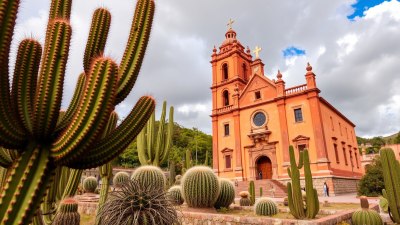Stories Written in Stone in Lalibela, Ethiopia
Explore the rich history and cultural significance of Lalibela's rock-hewn churches in Ethiopia.

Image created with Flux Schnell
The town of Lalibela, situated in the northern part of Ethiopia, is a place where faith and artistry merge in an astonishing way. Known primarily for its remarkable rock-hewn churches, Lalibela is often referred to as the 'New Jerusalem.' This name stems from the town’s historical significance in Christianity and its unique architectural marvels that tell stories written in stone. These structures are not merely religious edifices; they are embodiments of Ethiopian culture, spirituality, and resilience.
Lalibela's churches, carved directly into rock, date back to the 12th century during the reign of King Lalibela. This period marked a time of profound religious fervor and national identity, as Ethiopia sought to establish its own form of Christianity distinct from that of its neighbors. The churches were conceived as a pilgrimage site, allowing Ethiopian Christians to connect spiritually without traveling to Jerusalem. Thus, Lalibela was intended to mirror the holy city itself, projecting Ethiopia's importance in the Christian world.
The Architectural Splendor of Lalibela
Perhaps the most striking feature of the Lalibela churches is their extraordinary architecture. Each church is meticulously crafted, showing the skill and dedication of the artisans who built them. These impressive structures were not constructed in the traditional sense; rather, they are hewn from the solid basalt rock of the surrounding mountains. The churches showcase a combination of Christian iconography and Ethiopian cultural motifs, embodying a fusion of religion and artistry.
The most famous of these churches is the Church of Saint George, also known as Bete Giyorgis. It is shaped like a cross and famously stands alone, offering a stunning sight as it emerges from the earth. Carved entirely from a single piece of rock, it is an architectural triumph that exemplifies the ingenuity of the builders. Inside, intricate frescoes and carvings depict biblical narratives and saints, adding depth to the spiritual atmosphere.
Spiritual Significance and Pilgrimage
The rock-hewn churches of Lalibela are not simply tourist attractions; they are vital centers of worship and community for Ethiopian Orthodox Christians. Each year, thousands of pilgrims travel to Lalibela to worship, particularly during major religious festivals such as Timkat (Epiphany) and Fasika (Easter). These events attract visitors from around the world, who come to witness the colorful processions, traditional music, and the fervent faith of the local communities.
During Timkat, for example, the celebrations include a reenactment of Jesus' baptism, complete with vibrant ceremonies and dancing that showcases Ethiopia's rich cultural heritage. The atmosphere is electric, as the faithful gather to celebrate their shared beliefs, a testament to the enduring power of religion in this ancient kingdom.
Stories Embedded in the Stone
Each church in Lalibela is accompanied by a rich history and a collection of stories. According to local tradition, there was divine intervention in the creation of these sacred spaces. It is said that King Lalibela was guided by a vision from God, instructing him to build a new Jerusalem so that the Ethiopian people could worship without the hardship of travel. This narrative adds an ethereal quality to the already mystical landscape, where the stones resonate with centuries of prayer, devotion, and divine will.
The churches are also home to numerous legends that continue to be passed down through generations. For example, the church known as Bete Medhane Alem is considered the greatest of Lalibela's churches and symbolizes the body of Christ. According to local lore, it is said that the church was built overnight with the help of angels, further enhancing its significance in the eyes of believers. These stories create a powerful connection between the past and present, where every visitor is invited to experience a continuum of faith and artistry.
Preservation Challenges
Additionally, tourism poses both opportunities and challenges. While it brings attention to Lalibela and aids in funding preservation efforts, it also increases the risk of damage to the sites. Balancing the needs of conservation with those of local communities and tourists is crucial to the future of Lalibela. It is imperative that local authorities, international partners, and the traveling public work together to ensure that these sacred spaces remain intact for future generations.
The Global Impact of Lalibela
Lalibela's influence extends beyond Ethiopia's borders. Its churches have become symbols of faith and determination, inspiring people worldwide. The blend of architecture, spirituality, and history resonates with both travelers and scholars alike. As interest in Ethiopia grows, Lalibela serves as an entry point for many to understand the deeper narratives of Ethiopian history and the complexities of its religious landscape.
The churches of Lalibela have even been recognized as a UNESCO World Heritage Site, underscoring their global significance. Recognition brings not only awareness but also vital resources for preservation efforts, enabling the protection of this unique cultural heritage.
A Journey Through Time
Visiting Lalibela is not merely a journey to a geographical location but rather a passage through time. Each aspect of this town—the churches, the stories, the people—offers travelers a glimpse into a world where faith and history intertwine. As visitors walk through the narrow paths that connect the churches, they are often struck by the echoes of prayers and hymns that have resonated through the stones for centuries.
The serene ambiance invites reflection and contemplation, prompting individuals to delve into their own beliefs and experiences. Engaging with the local community allows for deeper insights into the customs and traditions that have shaped the identity of Lalibela. This immersive experience enriches one's understanding of Ethiopia’s role in the broader context of religious history.
The rock-hewn churches of Lalibela stand as testaments to the rich history, artistic genius, and spiritual devotion of the Ethiopian people. They are stories written in stone—each carving, each fresco, a narrative waiting to be discovered. As caretakers of these remarkable sites, the responsibility lies with both the Ethiopian community and the global audience to preserve this invaluable heritage. Lalibela is not only a destination; it is a destination filled with stories that invite everyone to partake in its profound legacy and to witness a form of faith that has withstood the test of time.











